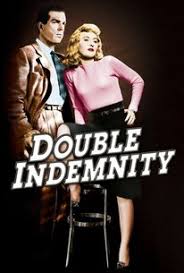
“They’ll hang ya just as sure as ten dimes’ll buy a dollar.”
Late at night a man makes his way into the offices of the Pacific All Risk Insurance Company in downtown Los Angeles. He has a gunshot wound in his shoulder. He sits down at his desk, lights a cigarette and begins talking into a Dictaphone. The man is Walter Neff (Fred MacMurray). He is dictating a letter to his boss Barton Keyes (Edward G. Robinson). A confession. In flashback Walter relates his story.
It started last May.
Walter stops at the house of a man named Dietrichson (Tom Powers). His automobile insurance is about to lapse and he wants to discuss with him the option of renewing the policy. Dietrichson isn’t home, but his wife Phyllis (Barbara Stanwyck) is. Phyllis is a beautiful blond. Walter is immediately attracted to her. Phyllis knows it. Phyllis brings the conversation around to life insurance. She wants to know if she can take out a policy on her husband without him knowing about it. You don’t have to hit Walter with a ton of bricks. He knows she is contemplating murder. He abruptly leaves.
At first he is not interested but thinking of the lovely Phyllis Dietrichson he begins thinking about it. Phyllis comes to see him at his apartment and begins seducing him. Walter is easily seduced and devises a plan to kill her husband and get away with it.
He sees Dietrichson again about the automobile policy. He has him sign what he thinks is two copies of the same policy. One is really for life insurance. One that has a double indemnity clause for accidental death. Now Walter puts into motion his plan.
“Double Indemnity” was released in 1944 and was directed by Billy Wilder. It is a crime drama and a film noir. The film is based on the book by James M. Cain. The screenplay was written by Billy Wilder and Raymond Chandler. The film was selected into the National Film Registry in 1992 for being "culturally, historically, or aesthetically significant". It was nominated for seven Academy Awards.
Normally noir films have a protagonist that is a hard-boiled detective or cop. This is the first one I’ve seen where the protagonist is a hard-boiled insurance salesman. Barbara Stanwyck was decked out in an ugly blond wig. Wilder said it was intentional to make her look sleazy. Paramount production head Buddy DeSylva said she looked like George Washington. She does. However you feel about Stanwyck’s wig the film itself is gripping and suspenseful. It’s classic noir with dark cinematography and the characteristic dialogue that makes it one of the best examples of the film noir style.
**SPOILER: The original ending to the novel was the double suicide of Walter and Phyllis; however suicide is a no-no in the Hayes Production Code. Murder, on the other hand, was just fine. Wilder wrote a different ending where Walter went to the gas chamber and Keyes watches. Once the final scene between Walter and Keyes was filmed Wilder decided that the gas chamber scene wasn’t really needed. The head of the Production Code had a problem with the gas chamber scene anyway. He felt that it was too gruesome and would not be accepted by local censor boards.**
James Cain based his novel on the true story of Ruth Brown Snyder. She was executed in the electric chair in 1928 for the murder of her husband Albert. Ruth began a torrid affair with Henry Judd Gray. Their affair went on for a couple years. Eventually Ruth began telling her lover that her husband abused her. Henry was a rather plain mundane man and not exactly the killing type. Ruth eventually wore him down and in March of 1927 Henry gave in. They pretty much botched everything from beginning to end. They were quickly caught, tried and convicted.
At about sixteen minutes into the movie Raymond Chandler has a cameo as a man sitting outside Barton Keyes' office reading a magazine. He glances up at Walter as he walks past.

